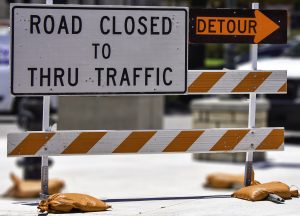It might seem that road closures and detours pop up randomly and with little thought, but that is not the case. For the North Split project, plans for the interstate closure and associated road closures and detours were developed and vetted during the environmental study. INDOT coordinated with multiple city agencies and community leaders to develop maintenance of traffic plans based on anticipated impacts to local traffic.
Traffic Management Plan and Meetings
 A Transportation Management Plan (TMP) was developed through the decision-making process and further refined by the project team. The project’s transportation management team meets weekly to review local and interstate traffic operations, efficiency of local traffic signal timing, bicycle and pedestrian safety, and upcoming detours ensure emergency responders and the public are informed.
A Transportation Management Plan (TMP) was developed through the decision-making process and further refined by the project team. The project’s transportation management team meets weekly to review local and interstate traffic operations, efficiency of local traffic signal timing, bicycle and pedestrian safety, and upcoming detours ensure emergency responders and the public are informed.
Transportation professionals are sensitive to public concerns about work zone congestion, delays and safety, and are continually developing new approaches to improve traffic operations in and around work zones.
Why Close A Street?
Completely closing streets and implementing a local detour decreases the overall time of construction and reduces impacts in the long run. Full closures also provide maximum workspace available to the contractor and improve safety for workers and travelers.
Detour Route Decision-Makers
Once it is determined that a street will be closed, transportation professionals meet with stakeholders to establish the detour route criteria. To do this, INDOT coordinates with:
- City of Indianapolis Department of Public Works
- Emergency responders (police, fire and EMTs)
- IndyGo
- Elected officials
- Indianapolis Metropolitan Planning Organization
- Individuals and community groups
Criteria for Detours
The following criteria are used by the stakeholders and designers to select the local detour routes:
- The detour route criteria must accommodate all vehicle types, including commercial vehicles (semis). Weight limits and turning radii may prevent certain streets from becoming detour routes.
- The detour route must also be reasonably close to the closure. If the detour is too far from the primary route, motorists who are unfamiliar with the area may not be comfortable navigating the detour.
- The detour must have sufficient capacity to accommodate the detoured traffic. For example, if traffic is diverted from a four-lane urban boulevard, a two-lane local street may not have adequate capacity to serve as a detour route.
- Potential impacts on bus stops are considered based on the potential of increased traffic and ensuring bus routes are maintained during construction.
Communicating Detours
A large portion of the TMP is public outreach, which is a key factor in the success of the North Split project.
Before a full road closure, the North Split communication team offers project status meetings with local neighborhood groups and businesses. We address their questions and have coordinated additional signage whenever possible.
The North Split communication team is willing to meet with any group that wants a status update on the project. Please contact the North Split communication team through INDOT’s Next Level Customer Service Center using the following methods:
- 1-855-INDOT4U (1-855-463-6848)
- indot4u.com
- indot@indot.IN.gov
Please include North Split in your email or when speaking directly to customer service.
